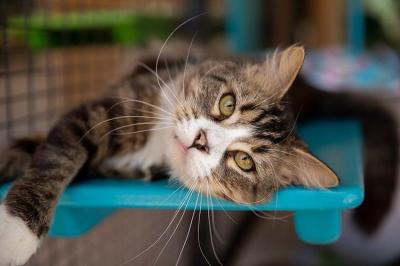
Feline Leukemia Virus (FeLV): Signs, Prevention, Prognosis
Feline leukemia virus (FeLV) is a viral infection that affects a cat’s immune system and bone marrow. The following are some frequently asked questions about the disease.
How contagious is feline leukemia?
Feline leukemia virus is typically spread from infected cats to non-infected cats through close personal contact, usually involving saliva. It can be spread by grooming, shared food bowls, bites, and other forms of close contact. It can also be transmitted from a mother cat to a kitten in utero and from the milk of an infected cat.
The virus does not live long outside of a cat host, so spreading FeLV via human clothing and hands is very unlikely. If an FeLV-positive cat is housed in a separate room from an FeLV-negative cat, it is unlikely that transmission will occur. To be on the safe side, food and water bowls should not be shared.
Can humans get feline leukemia?
Absolutely not.
What are the signs of feline leukemia?
There are no specific signs of a feline leukemia virus infection. In general, cats with FeLV have weaker immune systems, so they are more prone to infections such as upper respiratory infections, dental disease, and mycoplasma haemofelis that can cause anemia.
The only way to know whether your cat is FeLV-positive is to have your veterinarian run an ELISA test. Cats can test positive within a few weeks after exposure, and almost all cats positive for the virus will test positive within 28 days. However, testing positive just means that the virus is circulating in the cat’s blood. It does not mean that the cat will be permanently infected. It is possible for a cat to fight off the infection.
Home starts with you
Furthermore, no diagnostic test is perfect, and the ELISA test can give false negative or positive results. Additionally, any test performed represents only a single point in time. Various options for confirmatory testing are available, which you should discuss with your veterinarian.
Results also can be difficult to interpret definitively in some cases due to the complexity of this disease. Extended testing can provide additional information about prognosis (how likely a particular cat is to get sick from FeLV-related illness).
Can FeLV be treated?
There is no cure for FeLV, so most treatment of FeLV-positive cats involves supportive care. Because FeLV-positive cats have weaker immune systems, they do need to be treated for upper respiratory infections more often than FeLV-negative cats. They also tend to need dentals at a younger age than other cats.
How long can a cat live with feline leukemia?
Most cats with FeLV live normal lives, but their life span tends to be significantly shorter. Still, adult cats can live many healthy years with the illness.
Sadly, kittens contracting the disease often don’t fare as well. Around 80% of kittens with FeLV do not live past three years, and most die within a year. The young cats tend to die from feline infectious peritonitis (FIP), lymphoma (a cancer affecting lymphatic tissue), or bone marrow disease. It is less likely for older cats to get a persistent infection, and when they do they tend to handle the disease better.
What can be done to prevent the spread of FeLV?
Because there is no cure, prevention is the best treatment for FeLV. If an FeLV-negative cat is not around a FeLV-positive cat, the FeLV-negative cat will not get the virus. Although it varies depending on where a cat lives, roughly 2% to 3% of cats are FeLV-positive. So keeping your cats indoors should prevent exposure. Also, all cats coming into the household should be tested before introducing them to your cats.
There also is an FeLV vaccine. If your cat does go outside, or if you bring cats into your house that you cannot test or isolate, your cat should be vaccinated, especially at a young age.
Can an FeLV-positive cat live with other cats?
People who have cats might decide that they want to share their home with both FeLV-positive and FeLV-negative cats. FeLV-positive cats can live with other cats; however, negative cats should be vaccinated for FeLV if sharing a home with positive cats.
It’s important to note that while vaccination provides some protection, vaccines only range in effectiveness at preventing infection from 90% to 98% (depending on the study cited), and FeLV is difficult to study under natural conditions. A safe option is to keep negative cats vaccinated and to also prevent prolonged contact with positive cats (keeping them in separate rooms or portions of the house).
Can FeLV-positive cats have a good life?
FeLV-positive cats can live perfectly happy lives. People who have FeLV-positive cats just need to be aware that those cats might have a shorter life span and that they should be taken to a veterinarian as soon as a problem is noticed. Many people who adopt and care for FeLV-positive cats describe it as a deeply rewarding experience — and that they would gladly do it again.
